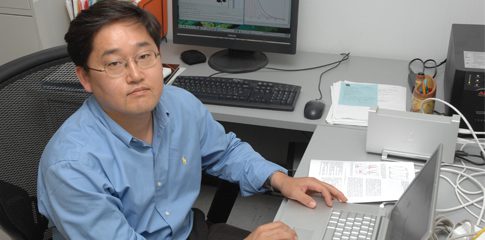Faculty Info
Name: Seogjoo “Suggy” Jang
Title:Associate Professor
Department: Chemistry and Biochemistry
Degree(s): PhD, University of Pennsylvania
Contact Information:
Phone: (718) 997-4110
“One good thing about theoretical chemistry is that you can do work wherever there is a place to sit down.”
– Seogjoo “Suggy” Jang
Past Profiles

Even in a dark, frozen Antarctic lake, purple bacteria are astoundingly efficient at turning light into chemical energy. Seogjoo “Suggy” Jang (Chemistry & Biochemistry) eagerly investigates what his lab terms the “great mystery” of photosynthesis. He does so not by boarding icebreakers but by breaking ground with quantum mechanical models. But that’s only the tip of Jang’s curiosity.
To fund his research on soft optoelectronic molecules, the National Science Foundation recently awarded Jang a prestigious Faculty Early Career Development grant worth $600,000. And more recently he received the $75,000 Camille Dreyfus Teacher-Scholar Award, which also supports promising young faculty.
The theoretical chemist aims to discover “what’s going on on a molecular level.” His research involves energy transfers, large-scale computation, and modeling complex spectroscopic data. The practical applications could include optical, electronic, and sensor devices; solar antennas; and new methods for converting the Sun’s rays to chemical and electrical energy.
As a child in Korea, Jang reflects, “I enjoyed reading about people going to far places. After I grew up, I realized there were not so many places left that I could explore, but I found there were so many things to explore intellectually.”
Fifteen years ago, when he came to the US, he was still developing his English skills. Since then he’s grown very fluent in terms like multichromophoric Forster resonance energy transfer and nonequilibrium Green function formalism.
Jang began teaching at Queens College in 2005. “I felt it was a great chance to really prove myself,” he recalls. He enjoys mentoring QC and high school students. “QC students are sincere and hard-working,” he notes. “They really are eager to learn. I feel a joy in helping each one.”
Book he recommends: American Prometheus: The Triumph and Tragedy of Robert J. Oppenheimer, by Kai Bird ad Martin J. Sherwin, which he says illuminates “what it’s like to live like a scientist.”
Musical interests: Classical piano, especially Erik Satie’s Gymnopédie and J.S Bach’s The Goldberg Variations.
Surprising fact: He writes with his left hand when solving difficult mathematical problems, perfecting theories, or writing letters, but uses his right hand for everyday writing purposes or when developing new ideas.

